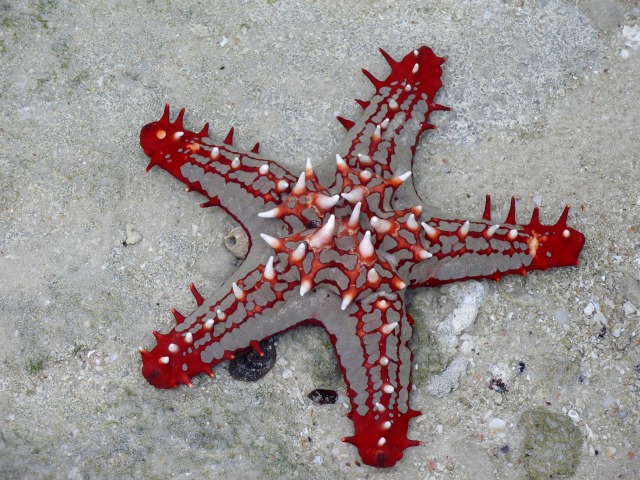The Dornenkronenseestern, or "thorn-crowned sea star" in English, refers to a type of sea star (starfish) known for its spiny appearance. This species is found in the Indian Ocean and the Red Sea, and it's scientifically named Acanthaster planci. While its distinctive crown of sharp spines gives it the name "thorn-crowned," it is also often known for being a coral-eating starfish, which has implications for the coral reefs it inhabits.
Key Features of the Dornenkronenseestern (Acanthaster planci):
-
Physical Appearance:
- The Dornenkronenseestern has a star-shaped body with five or more arms that radiate out from a central disk.
- Its most distinguishing feature is the long, spiny projections that cover its body, giving it a "thorn-crowned" appearance.
- The body can vary in color, typically ranging from brown to purple, and its spines can be quite sharp.
-
Habitat:
- This species is found predominantly in shallow coral reefs, particularly in the Indian Ocean and Red Sea regions, where it plays a significant role in the reef ecosystem.
- It often resides on the coral substrates of the reef, where it is sometimes seen feeding on coral polyps.
-
Diet and Feeding Behavior:
- Acanthaster planci is a coral-eating species, feeding primarily on the soft tissue of coral polyps. It uses its stomach to digest coral externally, a feeding process called extracorporeal digestion.
- While this is a natural part of the reef ecosystem, large populations of Dornenkronenseestern can lead to coral reef degradation. When their population explodes, they can cause significant damage to coral reefs by consuming large amounts of coral.
-
Ecological Impact:
- Under normal conditions, the thorn-crowned starfish helps to maintain a balance in the ecosystem, but when their populations grow out of control, often due to disruptions in the ecosystem, they can cause massive coral bleaching and reef destruction.
- Their populations can boom when there are disruptions, such as overfishing of their natural predators (like certain fish species) or changes in water quality. Outbreaks of Acanthaster planci can lead to the degradation of coral reefs, which affects the broader marine ecosystem.
-
Reproduction:
- The Dornenkronenseestern reproduces through spawning, where both males and females release their gametes into the water, where fertilization occurs externally. The larvae eventually settle on the reef, where they grow into juvenile starfish.
-
Predators and Control:
- Natural predators of the thorn-crowned starfish include certain species of fish, like the moray eel, and crabs, as well as sunfish. However, in areas where overfishing has reduced these natural predators, the Acanthaster planci populations can increase significantly.
- In efforts to control the damage caused by Acanthaster planci, certain management programs have been implemented, such as manually removing large numbers of the starfish from coral reefs to protect coral populations.
Why It’s Important to Study the Dornenkronenseestern:
Understanding the Dornenkronenseestern is important for the health of coral reefs, as outbreaks can lead to major disruptions in the marine ecosystem. Researchers and marine conservationists study the Acanthaster planci to develop better ways of managing reef health and protecting coral communities, as they are vital to marine biodiversity.
While the thorn-crowned sea star plays a natural and vital role in coral ecosystems, careful management is essential to prevent it from becoming a threat to the coral reefs it inhabits.





